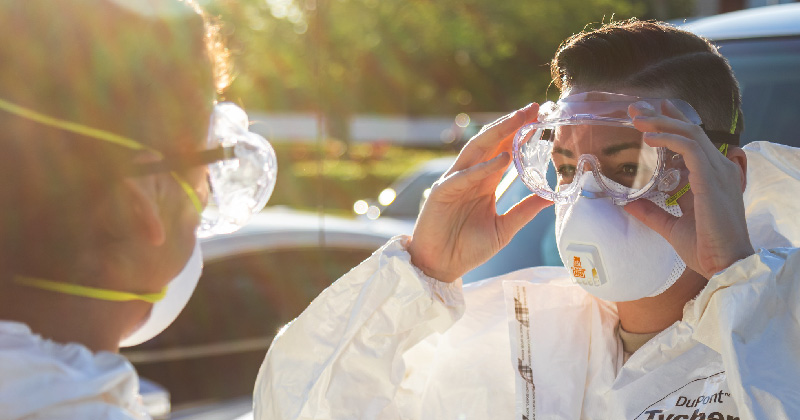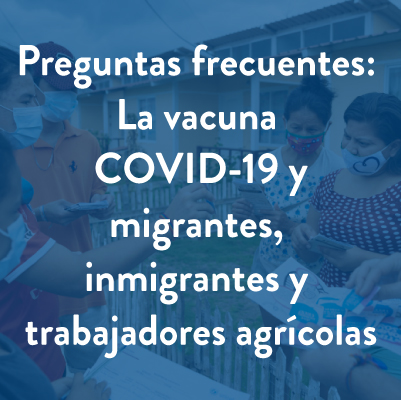- Who We Are
- Clinician Employment
- Publications
- Witness to Witness (W2W)
- El Premio Kugel & Zuroweste a la Justicia en la Salud
- Your Voice Matters: Photovoice Project
Guest Blog: New WHO Guidance on Masks for COVID-19 Ignores Findings of its Own Evidence Review Calling for More Protective Measures
Wed, 06/10/2020 | by MCN Admin


[Editor’s Note: Today’s blog post comes from Rory O’Neill, Occupational Health and Workplace Safety Advisor for the International Trade Union Confederation, editor of Hazards magazine and professor at the University of Liverpool School of Law and Social Justice, England. His commentary, originally published through an occupational health listserv and on Twitter, includes the perspective of Peg Seminario, the former AFL-CIO Safety and Health Director. Their comments have been edited.]
The World Health Organization (WHO) has issued new interim guidance on the masks required for health care workers at risk from Covid-19, “Advice on the Use of Masks in the Context of COVID-19." It reasserts WHO’s unquestionably dangerous advice that most health care workers need only use surgical/medical masks (rather than respirators) that offer relatively little protection. A consequence is that some health care workers will continue to be exposed and infected and will die in circumstances that could have been avoided. The WHO advice will inevitably mean other at-risk work groups, including those is home care settings or required to undertake essential work in settings where physical distancing isn’t always possible, will likewise be placed at risk.
When WHO released this June 5th ‘interim guidance,’ it was in possession of a WHO-commissioned Lancet review, entitled, “Physical Distancing, Face Masks, and Eye Protection to Prevent Person-to-Person Transmission of SARS-CoV-2 and COVID-19: A Systematic Review and Meta-Analysis,” and published on June 1st, that calls for high protection respirators (e.g. N95/FFP3) as a ‘minimum’ for health care workers, together with other PPE including eye protection and gowns. Several WHO officers had reviewed and commented on the Lancet review prior to publication. WHO, though, chose to discount evidence it had commissioned and partly financed.
WHO’s decision certainly isn’t science- nor health based. It suggests the agency has been captured by the private health care industry and the employers’ lobby, who either don’t want to pick up the bill or don’t want to admit there might be legal liability for coronavirus-related occupational disease.
Peg Seminario, an adviser to the US national union federation AFL-CIO, describes the WHO guidance as “incredibly harmful” and likely to undermine existing workplace protections:
For health care workers, the new guidance maintains the irresponsible, unprotective, unsupported earlier WHO guidance that health care workers caring for COVID patients need only wear a medical/surgical mask, except those involved with aerosol-generating procedures. The document ignores all evidence of aerosol transmission and misrepresents research on the much greater effectiveness of N95 and more protective respirators. The new guidelines also now recommend the use of medical/surgical masks for others working in health care settings.
For the public, WHO is recommending that individuals wear cloth face coverings composed of three layers. Cloth coverings are also recommended for workers who are working in environments with close contact to the public or co-workers, and a high potential for exposure, when physical distancing cannot be achieved.
For vulnerable individuals (e.g. older than 60, immunocompromised, with underlying medical conditions), they are recommending the use of medical/surgical masks. These guidelines are incredibly harmful for health care workers and are sure to be used by the hospitals and others in an attempt to weaken protections for health care workers here in the United States.
The Lancet meta-analysis of 172 observational studies across Covid-19 but also predominately SARS and MERS, also concludes a physical distancing requirement of two meters is twice as protective as WHO’s recommendation of at least one meter, far less protective than that considered necessary by many public and workplace health agencies. The International Trade Union Confederation (ITUC) and the Council of Global Unions have called on WHO to improve its guidance. PSI has presented consistently to WHO robust arguments for better protective equipment and greater physical distancing. WHO has now ignored both the findings of its own commissioned and partly financed review from the Lancet, and the repeated calls from unions and many leading academics and public health bodies.
WHO’s behavior is shameful, dangerous, and antithetical to its goal of promoting health and wellbeing.
Read the WHO’s Advice on the Use of Masks in the Context of COVID-19.
Read the Lancet’s Physical Distancing, Face Masks, and Eye Protection to Prevent Person-to-Person Transmission of SARS-CoV-2 and COVID-19: A Systematic Review and Meta-Analysis.
‘Unacceptable risk’ to frontline workers, says expert
Health care workers are not being given the protection they deserve and are contracting deadly infections as a result, a top biohazards expert has warned. Writing in a commentary in the Lancet in response to the simultaneously published Lancet review on the efficacy of physical distancing, face masks, and eye protection against COVID-19 transmission, Raina MacIntyre, an epidemiologist at the University of New South Wales in Sydney, Australia, noted the World Health Organization's current Covid-19 guidance, which has been the template for health worker protection, is failing health workers by refusing to recommend respirators for a wide range of health care work. “This kind of denial, what purpose is it serving — except to harm health care workers?” she told journalists, adding WHO’s current guidelines reflected shortages of respirators rather than good practice. “Guidelines should be based on evidence, not on supplies,” she noted. “It’s like telling an army, ‘Oh sorry, we’ve run out of guns, just take these bows and arrows and face the enemy.’”
In her commentary, co-authored by Quanyi Wang, MacIntyre said WHO’s acceptance of surgical masks was harming workers. “Although medical masks do protect, the occupational health and safety of health workers should be the highest priority and the precautionary principle should be applied. Preventable infections in health workers can result not only in deaths but also in large numbers of health workers being quarantined and nosocomial [hospital originated] outbreaks. In the National Health Service trusts in the UK, up to one in five health workers have been infected with Covid-19, which is an unacceptable risk for frontline workers.” MacIntyre and Wang’s commentary is scathing about WHO’s promotion of an at least one meter (three feet) physical distancing standard. “The 1–2 m distance rule in most hospital guidelines is based on out-of-date findings from the 1940s, with studies from 2020 showing that large droplets can travel as far as 8m. To separate droplet and airborne transmission is probably somewhat artificial, with both routes most likely part of a continuum for respiratory transmissible infections.” MacIntyre concluded: “Protection against presumed droplet infections by use of respirators, but not masks, supports a continuum rather than discrete states of droplet or airborne transmission. Both experimental and hospital studies have shown evidence of aerosol transmission of SARS-CoV-2.”
Read the complete commentary by Raina MacIntyre and Quanyi Wang on the Lancet website: Physical distancing, face masks, and eye protection for prevention of COVID-19.
Like what you see? Amplify our collective voice with a contribution.
Got some good news to share? Contact us on our social media pages above.
Return to the main blog page or sign up for blog updates here.







